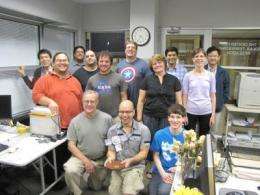Lanzerotti's launch makes it: Wee hour party at NJIT sees Atlas V take-off

Rivaling the kind of devotion reserved for rock stars, a band of space weather groupies surrounding NJIT Distinguished Research Professor Lou Lanzerotti stayed up all night into the next day to witness the long-awaited launch of Atlas V.
More than a dozen of these hearty souls showed up to party at 3 a.m. on Aug. 30, 2012 in Tiernan Hall on the NJIT campus, to witness via NASA TV the 4 a.m. launch from Cape Canaveral of the twin Radiation Belt Storm Probes (RBSP) mission.
Lanzerotti is the principal investigator behind one of five instruments aboard the RBSP. The launch had already been cancelled several times due to a combination of technical glitches and poor weather. Thankfully, both issues were resolved. In anticipation of the original blast-off, The Star-Ledger reported last week on Lanzerotti and the effort.
The mission was funded by NASA's Living With a Star program which is managed by Goddard Space Flight Center. The Johns Hopkins University Applied Physics Laboratory (APL) managed the RBSP mission and built and operates the two RBSP spacecraft for NASA.
The entire project began in 2006. NJIT will ultimately receive about $15 million in NASA funding for its role in developing and building the space weather instrument RBSP Ion Composition Experiment known as RBSPICE. Each RBSP spacecraft weighs about 660 kilograms (1,455 pounds) and carries an identical set of five instrument suites that will enable scientists to unlock the mysteries of the radiation belts surrounding Earth.
Back in Newark when finally the big moment arrived at 4 a.m.— really, check the clock—the gang was on board. Explains NJIT Physics Professor Andy Gerrard: "We projected the entire NASA launch onto a 50-inch screen and used external speakers, complete with subwoofer, to get that unique rumble feeling. As we watched the launch, Lou, who couldn't be with us, called in and we put him on speaker phone so we could share the moment together.
"And then we saw the launch. We watched it go up in space. We saw the first stage separation, then the second stage activation. We basically tracked the entire start of the mission!
"We then celebrated by popping the champagne corks with Lou still on speaker phone. There was a toast to RBSP and then to Lou. Earlier we had put out coffee and donuts. Many of the students were actually here the entire night."
Provided by New Jersey Institute of Technology